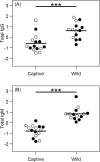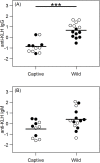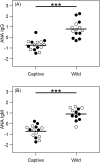Markedly Elevated Antibody Responses in Wild versus Captive Spotted Hyenas Show that Environmental and Ecological Factors Are Important Modulators of Immunity
- PMID: 26444876
- PMCID: PMC4621877
- DOI: 10.1371/journal.pone.0137679
Markedly Elevated Antibody Responses in Wild versus Captive Spotted Hyenas Show that Environmental and Ecological Factors Are Important Modulators of Immunity
Abstract
Evolutionary processes have shaped the vertebrate immune system over time, but proximal mechanisms control the onset, duration, and intensity of immune responses. Based on testing of the hygiene hypothesis, it is now well known that microbial exposure is important for proper development and regulation of the immune system. However, few studies have examined the differences between wild animals in their natural environments, in which they are typically exposed to a wide array of potential pathogens, and their conspecifics living in captivity. Wild spotted hyenas (Crocuta crocuta) are regularly exposed to myriad pathogens, but there is little evidence of disease-induced mortality in wild hyena populations, suggesting that immune defenses are robust in this species. Here we assessed differences in immune defenses between wild spotted hyenas that inhabit their natural savanna environment and captive hyenas that inhabit a captive environment where pathogen control programs are implemented. Importantly, the captive population of spotted hyenas was derived directly from the wild population and has been in captivity for less than four generations. Our results show that wild hyenas have significantly higher serum antibody concentrations, including total IgG and IgM, natural antibodies, and autoantibodies than do captive hyenas; there was no difference in the bacterial killing capacity of sera collected from captive and wild hyenas. The striking differences in serum antibody concentrations observed here suggest that complementing traditional immunology studies, with comparative studies of wild animals in their natural environment may help to uncover links between environment and immune function, and facilitate progress towards answering immunological questions associated with the hygiene hypothesis.
Conflict of interest statement
Figures





Similar articles
-
Socioecological predictors of immune defences in wild spotted hyenas.Funct Ecol. 2016 Sep;30(9):1549-1557. doi: 10.1111/1365-2435.12638. Epub 2016 Feb 29. Funct Ecol. 2016. PMID: 27833242 Free PMC article.
-
Development of a hyena immunology toolbox.Vet Immunol Immunopathol. 2012 Jan 15;145(1-2):110-9. doi: 10.1016/j.vetimm.2011.10.016. Epub 2011 Nov 2. Vet Immunol Immunopathol. 2012. PMID: 22173276 Free PMC article.
-
Characterization of Toll-like receptors 1-10 in spotted hyenas.Vet Res Commun. 2014 Jun;38(2):165-70. doi: 10.1007/s11259-014-9592-3. Epub 2014 Feb 2. Vet Res Commun. 2014. PMID: 24488231 Free PMC article.
-
The Complementary Role of Gestures in Spotted Hyena (Crocuta crocuta) Communication.Animals (Basel). 2025 May 9;15(10):1366. doi: 10.3390/ani15101366. Animals (Basel). 2025. PMID: 40427244 Free PMC article. Review.
-
Society, demography and genetic structure in the spotted hyena.Mol Ecol. 2012 Feb;21(3):613-32. doi: 10.1111/j.1365-294X.2011.05240.x. Epub 2011 Aug 31. Mol Ecol. 2012. PMID: 21880088 Review.
Cited by
-
Life-history stage influences immune investment and oxidative stress in response to environmental heterogeneity in Antarctic fur seals.Commun Biol. 2024 Jun 29;7(1):788. doi: 10.1038/s42003-024-06499-6. Commun Biol. 2024. PMID: 38951600 Free PMC article.
-
Fecal microbiota associated with phytohaemagglutinin-induced immune response in nestlings of a passerine bird.Ecol Evol. 2018 Sep 20;8(19):9793-9802. doi: 10.1002/ece3.4454. eCollection 2018 Oct. Ecol Evol. 2018. PMID: 30386575 Free PMC article.
-
Possible spread of SARS-CoV-2 in domestic and wild animals and body temperature role.Virus Res. 2023 Apr 2;327:199066. doi: 10.1016/j.virusres.2023.199066. Epub 2023 Feb 10. Virus Res. 2023. PMID: 36754290 Free PMC article. Review.
-
Socioecological predictors of immune defences in wild spotted hyenas.Funct Ecol. 2016 Sep;30(9):1549-1557. doi: 10.1111/1365-2435.12638. Epub 2016 Feb 29. Funct Ecol. 2016. PMID: 27833242 Free PMC article.
-
The environment as a driver of immune and endocrine responses in dolphins (Tursiops truncatus).PLoS One. 2017 May 3;12(5):e0176202. doi: 10.1371/journal.pone.0176202. eCollection 2017. PLoS One. 2017. PMID: 28467830 Free PMC article.
References
-
- Folstad I, Karter AJ. Parasites, bright males, and the immunocompetence handicap. Am Nat. 1992;139(3):603–22.
MeSH terms
Substances
Grants and funding
LinkOut - more resources
Full Text Sources
Other Literature Sources
Molecular Biology Databases

